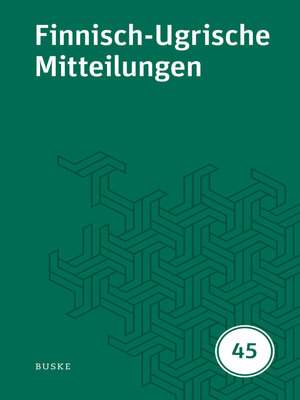Finnisch-Ugrische Mitteilungen Band 45
ebook ∣ Finnisch-Ugrische Mitteilungen
By Cornelius Hasselblatt

Sign up to save your library
With an OverDrive account, you can save your favorite libraries for at-a-glance information about availability. Find out more about OverDrive accounts.
Find this title in Libby, the library reading app by OverDrive.



Search for a digital library with this title
Title found at these libraries:
| Library Name | Distance |
|---|---|
| Loading... |
Abstracts
Originalia:
Elizaveta Kotorova (Zielona Góra / Tomsk) – Andrey Nefedov (Hamburg): Besonderheiten des Kommunikationsverhaltens der indigenen sibirischen Völker (am Beispiel des Ketischen)
The peculiarities of communicative behavior within the national culture are determined, on the one hand, by certain linguistic means, and on the other hand, by the rules defining how to use these means. In this article, we identify the following main features of speech behavior patterns implemented by speakers of indigenous languages of Siberia, in particular by the Ket language speakers: 1) Etiquettical speech behavior patterns are implemented in most cases not verbally, but actionally; 2) There are practically no native politeness formulas, instead of them arbitrarily formulated statements or borrowed etiquette clichés are used; 3) Informative speech behavior patterns can be implemented both verbally and actionally; 4) Such communicative and pragmatic factors as age, social status and social distance do not seem to affect the implementation of directive speech behavior patterns.
Miika Lehtinen (Oulu): Skolt Saami passive verbs
This paper deals with the Skolt Saami passive verb suffixes -j- and -õõvvâ- (e.g. mott-j-ed 'change (intr.)', rottš-õõvvâ-d 'be pulled') cognate with North Saami -o(j)- and -uvva- (e.g. dahkk-o-t 'be done', muhttaš-uvva-t 'change (intr.)') as well as Finnish -u- ~ -y- (e.g. käänt-y-ä 'turn (intr)'). The research material has two complementary parts: a dialectal dictionary and a speech corpus. The semantics of the relevant verbs in the material is examined. The main distinction is made between intentional passives (true passives having a volitional agent) and automative passives (actions that happen spontaneously or by accident, anticausatives). The results show that at least the suffix -jed and to a lesser extent -õõvvâd are mainly used to mark automative passives, but some instances of intentional passives are also found as well as some cases that are ambiguous between the two. The suffix -õõvvâd is used in the passive function more rarely than the suffix -jed and it has more functions.
Sándor Maticsák (Debrecen): Die mordwinische Sammlung aus der Orenburg-Expedition von Pallas (1768–1774)
The 1769 transit of the Venus across the Sun was always an important astronomical event, because it made possible for astronomers to calculate the distance between the Sun and the Earth. 151 scientists and scholars travelled to 77 pre-selected spots around the world to observe the transit.
In 1768, the Imperial Academy of St. Petersburg organized five expeditions besides the Venus-observing teams to explore the flora, the fauna, the geological and the meteorological characteristics of far-off territories in Russia. The travellers obtained a large amount of information about the residents, customs, lifestyle and culture of these far-off lands, including some linguistic material as well. They wrote travelogues about their experiences.
The leader of the expedition was Peter Simon Pallas (1741–1811), the renowned Swedish natural scientist, and the subdivisions were led by German, Swedish and Russian scientists and scholars. Between 1768 and 1774, Pallas travelled around the Middle Volga Region, the Orenburg Region, Bashkortostan, Southwest Siberia and finally he reached as far as Buryatia. His travelogue was published in three volumes between 1771 and 1776 titled Reise durch verschiedene Provinzen des Russischen Reichs.
Pallas's book contains linguistic material from several languages, Mordvin, Khanty, Mansi, Samoyedic, Mari and Udmurt included. Most of the words are animal and plant names and vocabulary related to clothing and religious beliefs. The Mordvin material is made...







